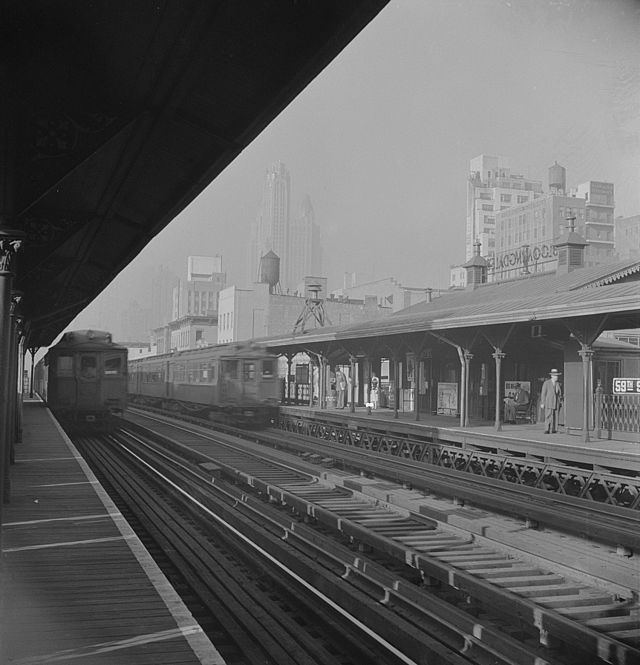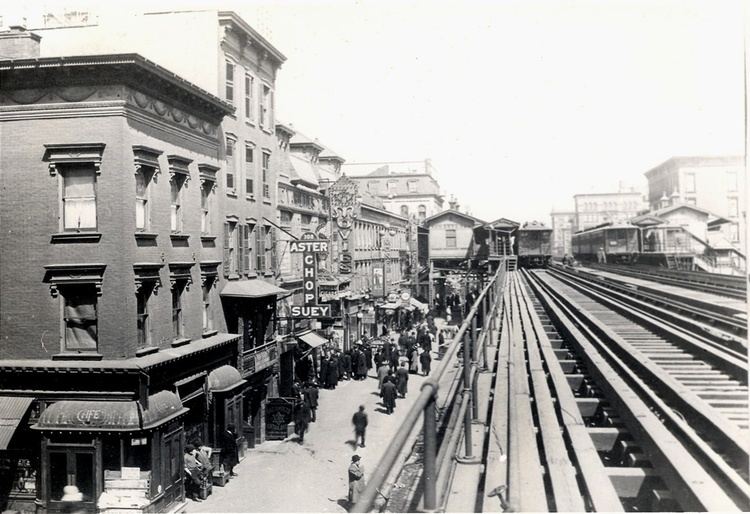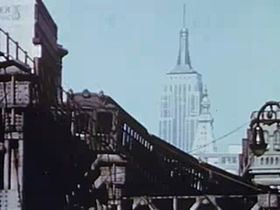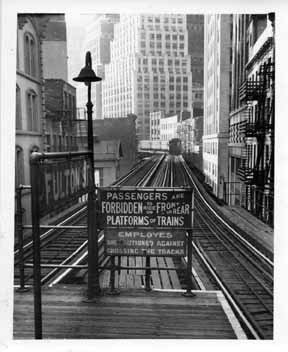 | ||
The IRT Third Avenue Line, commonly known as the Third Avenue El and the Bronx El, was an elevated railway in Manhattan and the Bronx, New York City. Originally operated by the New York Elevated Railway, an independent railway company, it was acquired by the Interborough Rapid Transit Company (IRT) and eventually became part of the New York City subway system.
Contents

The first segment of the line, with service at most stations, opened from South Ferry to Grand Central Depot on August 26, 1878. Service was extended to Harlem in Manhattan on December 30. Service in Manhattan was phased out in the early 1950s and closed completely on May 12, 1955, and ended in the Bronx on April 29, 1973.

The Third Avenue El was the last elevated line to operate in Manhattan, other than the 1 train on the IRT Broadway–Seventh Avenue Line (which has elevated sections between 122nd and 135th Streets and north of Dyckman Street), and was a frequent backdrop for movies. Service on the Second, Sixth and Ninth Avenue El lines was terminated in 1942, 1938, and 1940, respectively.

Operation

In 1875, the Rapid Transit Commission granted the New York Elevated Railway Company the right to construct the railway from Battery Park to the Harlem River along the Bowery and Third Avenue. At that time the company already operated the Ninth Avenue Elevated, which it acquired in 1871 after the bankruptcy of the West Side and Yonkers Patent Railway. The Third Avenue El opened in 1878, running from South Ferry to 129th Street. The Manhattan Railway Company took control of the New York Elevated Railroad in 1879. In 1886, the Suburban Rapid Transit Company commenced operations with a railway line over the Harlem River (via a double-decked swing bridge located between the Third Avenue Bridge and Willis Avenue Bridge with the upper deck carrying the express tracks, the lower one the local tracks, and a pedestrian walkway) from the Manhattan Railway's northern terminal at 129th Street to 133rd Street in the southern Bronx, known then as the "Annexed District". The Manhattan Railway assumed operations of the Suburban in 1891 as an extension of the Third Avenue Line, and through service between the Bronx and Manhattan began in 1896. A 999-year lease of the Manhattan Railway was brokered by the Interborough Rapid Transit Company in 1902, for which rapid transit services in the Bronx, of which the Third Avenue Line was a part, would eventually be coordinated alongside the new subway. Around this time, the line was electrified.

As part of the Dual Contracts, this line was triple-tracked. The project, which caused minimal disruption to the line itself while works were ongoing, allowed for weekday peak direction express service and increased train capacity on the line. For New York City's transportation system, the project was "a more important engineering feat than the building of the Panama Canal" according to the IRT. The center track of the Bronx portion opened on January 17, 1916; in Manhattan it was opened on July 9, 1917.
As of 1934, the following services were being operated:

In December 1937, some weekday midday and evening, Saturday midday thru evening local-expresses, and all Sunday and late-night locals were extended to 241st Street, replacing shuttles except northbound in the AM peak and southbound in the PM peak.
In 1943, Sunday evening local trains were rerouted to City Hall, with shuttles from Canal Street running to South Ferry. On November 5, 1946, service to Freeman Street was stopped, and all weekday and Saturday morning peak locals were routed to South Ferry. In 1947, Saturday service was further reduced. 129th Street local trains were eliminated, as were morning peak thru-expresses, which were changed to local-expresses. Saturday midday and evening local-expresses ran from South Ferry or City Hall to Tremont Avenue–177th Street (IRT Third Avenue Line), and locals from South Ferry or City Hall to Bronx Park. On April 22, 1950, Saturday morning local-expresses were converted to locals. On April 30, 1950, all Sunday locals were routed to South Ferry, with a shuttle connection from Canal Street to City Hall. However, on December 22, the line from Chatham square to South Ferry was closed, with all trains running to City Hall except weekday peak locals that ended at Chatham Square. In addition, weekday peak service north of Gun Hill Road was eliminated, as were weekday locals to 129th Street.
On March 14, 1952, service south of 149th Street was reduced to weekday daytime only, with Gun Hill Road to 149th Street locals at other times. On May 29, 1952, weekday midday local-expresses were eliminated. On June 26, 1952, thru-expresses were cut back to Gun Hill Road. On November 21, 1952 morning peak Locals were cut back from Chatham Square to Canal Street, and PM peak locals were cut back from Fordham Road to 129th Street. However, this resulted in severe overcrowding, so local service to Fordham Road in the PM peak direction was resumed December 3, 1952. On December 31, 1953 the Chatham Square to City Hall portion of the line was closed. Service then consisted of local trains from Tremont Avenue or 129th Street and Canal Street in the weekday morning peak, Gun Hill Road and Chatham Square midday, and Chatham Square and 129th Street or Tremont Avenue in the PM peak. Local-expresses and thru-expresses operated between Gun Hill Road and Chatham Square southbound in the AM and northbound in the PM peak hours. Evening, all-night, and weekend service was Gun Hill Road to 149th Street locals. When the El was closed in Manhattan in 1955, the East Side was left with only the overcrowded IRT Lexington Avenue Line as the only subway east of Fifth Avenue.
Closures
In the 1930s and '40s, as part of the integration of the different subway companies in New York City—the IRT along with Brooklyn–Manhattan Transit (BMT) and Independent Subway System (IND)—the Third Avenue El and its counterparts on Second, Sixth, and Ninth Avenues came under criticism from New York mayor Fiorello La Guardia and his successors. The Els were regarded as blights on their communities and obsolete, since the subways were being built or were planned to replace them.
The IND Sixth Avenue Line and the IND Eighth Avenue Line rendered the Sixth and Ninth Avenue Els obsolete, except for a small shuttle that served the Polo Grounds on the Ninth Avenue Line. They were closed by 1940 and demolished by 1941. The Second Avenue El was also gradually demolished from 1940 to 1942. When the Second Avenue El was closed June 13, 1942, the weekday and Saturday Chatham Square to Freeman Street via the West Farms line service was rerouted via the Third Avenue Line, running express south of 129th Street. The Third Avenue El was kept open because it was intended to stay in use until the Second Avenue Subway was built to replace it. Pressure against the El from real estate interests soon began, with creation in 1941 of the Third Avenue Elevated Noise Abatement Committee, which consisted of what the New York Times described as "men in the real estate business." The committee initially sought a decrease in train service, saying the noise from the El "constitutes a menace to health, comfort and peaceable home life."
The system was closed in sections from 1950 to 1973. First, the South Ferry spur, which connected South Ferry to Chatham Square, was closed in 1950. This permanently closed the South Ferry elevated station, which had previously served all four IRT El lines that originally ran in Manhattan. The Bronx Park terminal station was closed November 14, 1951, with morning peak and midday locals thenceforth running to Gun Hill Road, and afternoon peak locals running to Fordham Road. Morning peak local-express trains started at Fordham Road, while PM peak local-express trains were extended to Gun Hill Road. Next to close was the City Hall spur in 1953, which started at Park Row in Manhattan and then connected with the South Ferry spur at Chatham Square. On May 12, 1955, the main portion of the line closed from Chatham Square to East 149th Street in the Bronx, ending the operation of elevated service in Manhattan. The removal was a catalyst in a wave of new construction adding property values on the East Side, and the head of the Real Estate Board of New York suggested that Third Avenue be renamed "The Bouwerie" to symbolize the transformation.
In the 1960s, the remaining service in the Bronx was named the 8, although trains did not display this designation and instead read "SHUTTLE". Beginning in the 1960s under the MTA's Program for Action, plans were made for demolition of the remaining line as part of the city's effort to remove "obsolete elevated railway structures," which also saw the razing of portions of the BMT Jamaica elevated in Queens. It was to be replaced with a parallel line along the Metro-North Harlem Line's right-of-way, part of the Second Avenue Subway plan. Local residents and business owners also sought similar revival seen following the closure of the line's sections in Manhattan. The remaining portion in the Bronx from East 149th Street to Gun Hill Road finally closed on April 29, 1973 and demolition started on March 9, 1977. Demolition was completed by the end of 1977, along with the condemned portion of the Jamaica Line.
The planned Second Avenue Subway was never completed, due to the 1970s fiscal crisis. In the Bronx, the Third Avenue el was replaced by the Bx55 bus making only the stops the train made. This bus route was one of the first to have free transfers to and from the subway, with the two transfer points at the 3rd Avenue – 149th Street and Gun Hill Road White Plains Road IRT stations, and was one of three. The other two bus-subway transfers were from the B35 and B42 in Brooklyn, which replaced the BMT Culver Line and BMT Canarsie Line, respectively. With the introduction of free bus to subway transfers systemwide in the 1990s, the three routes lost their special status, although the B42 terminates in a loop inside fare control at Rockaway Parkway. In 2013, the Bx55 was eliminated. It was partially replaced by the Bx15 Limited, which runs to West Harlem via 125th Street, but does not extend past Fordham Plaza to Gun Hill Road.
In popular culture
The El was featured in a number of films, including:
The El was also the backdrop for Jack Finney's novel Time and Again (1970).
Several early silent films were made of New York's elevated trains, including the Third Avenue El. A documentary, 3rd Avenue El, was made in the 1950s and is available for viewing on the Internet.
